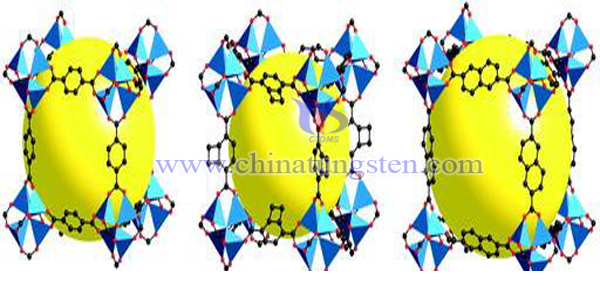Phosphotungstic Acid-Organometallic Framework Catalytic Material
- Details
- Category: Tungsten Information
- Published on Thursday, 06 June 2019 15:48
Biomass can be regarded as a promising alternative energy source for petroleum. The key to convert biomass into important energy materials and basic platform compounds is to convert cellulose, an important component of biomass, into glucose by directional hydrolysis.
Cellulose hydrolysis is first converted to glucose, and then glucose is further isomerized, dehydrated, rehydrated, hydrogenated to fructose, 5-hydroxymethyl furfurfural, levulinic acid, and polyols including sorbitol, mannitol, ethylene glycol and other important energy materials and basic platform compounds.

Some researchers have found a phosphotungstic acid-organometallic skeleton catalytic material which can be used to catalyze cellulose hydrolysis. Its characteristics are as follows:
Phosphotungstic acid is immobilized in the pore structure of organometallic skeleton materials with both alkaline and strong electronegative groups, and organometallic skeleton utilizes the limitation of pore size and the basic group of its active functional group. Phosphotungstic acid is immobilized by electrostatic binding with phosphotungstic acid. The preparation method of the material includes the following steps:
Solvents, organic ligands, metal sources and phosphotungstic acid were mixed and stirred evenly, heated from room temperature to 110 ~220 ℃, kept at 110 ℃ 220 ℃ for 8~36 h), centrifuged and separated after cooling, the settled solid was washed with N, N-dimethylformamide at room temperature, then filtered, washed repeatedly until the filtrate was clear and transparent, and filtered after washing. The obtained solids were vacuum dried for 10-16 h at 60 ~80℃, and then the phosphotungstic acid-organometallic skeleton multifunctional materials were obtained.
Phosphotungstic acid-metal organic skeleton was used to catalyze cellulose hydrolysis: 0.02g starch, 0.1g phosphotungstic acid-metal organic skeleton multifunctional material and 10mL distilled water were added into 25 mL COD digestion tube in turn, and then reacted with magnetic rotor at 120 ℃ for 5 h. The reaction process was stirred continuously, centrifugal separation was completed, and the product was separated. The upper clarifier is starch hydrolysate, and the settling solid is a mixture of catalyst and unreacted starch. After the reaction, the catalyst was washed repeatedly with distilled water for three times. After centrifugal separation, the solid was deposited in the centrifugal tube and dried in vacuum for 10 hours at 60 ℃. The solid powder obtained was the recovered catalyst. The hydrolysis of starch was repeated with the recovered catalyst for five times, and the yield of glucose was kept at 18.93%-19.98%.
Compared with ordinary catalysts, phosphotungstic acid, the active component of phosphotungstic acid in phosphotungstic acid-metal organic framework catalytic materials, directly participates in the synthesis of metal organic framework. The electrostatic interaction between basic groups and phosphotungstic acid can ensure the immobilization efficiency of phosphotungstic acid, simplify the operation steps of immobilization of phosphotungstic acid, make phosphotungstic acid uniformly distributed on the carrier and reduce the loss of phosphotungstic acid in the hydrolysis reaction. The catalyst can be recycled for many times, and the catalytic activity has not decreased significantly.
- Tungsten Oxide Manufacturer & Supplier, Chinatungsten Online: www.tungsten-oxide.com
- Tungsten News & Prices of China Tungsten Industry Association: www.ctia.com.cn
- Molybdenum News & Price: news.molybdenum.com.cn
- Tel.: 86 592 5129696; Fax: 86 592 5129797; Email: sales@chinatungsten.com



 sales@chinatungsten.com
sales@chinatungsten.com